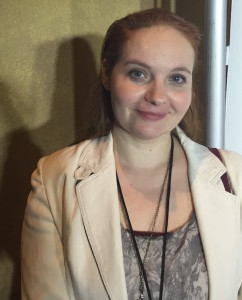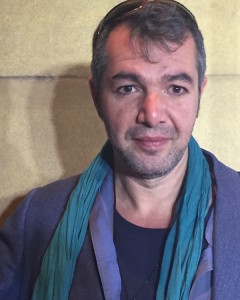Arpa Film Festival 2015 interviews with film directors
Documentary Film, Armenopolis, Armenian Soul is screening at the 18th Annual Arpa International Film Festival on November 15 at 12:30 p.m. This is the forth film that directing partners, Izabela “Elisabeta” Bostan and Florin Kervorkian have made together. Not only do they work beautifully together making films, they do the same in their co-parenting relationship with their children.
Armenopolis, Armenian Soul is a cinematic essay on the history of Armenopolis and the life, joy, pain and memories experienced there. Directed by Florin Kevorkian and Isabella Bostan Kevorkian, this documentary is an invitation to admire a Baroque city, an authentic museum in open space, a place designed for the future, for families, with love and passion. Gherla is a city built from scratch, on a land bought back in the early 17th century, by an Armenian community who had left for Moldova. The city has managed to preserve its most important institutions: Solomon Church, Karatsony House, City Hall, orphanages, high school and park. Armenopolis-Gherla is a city designed to defeat history, with houses more than 250 years old.
For the documentary Bostan had the roles of producer and co-director, while Kevorkian took on writing and co-directing. Sharon Swainson, writer for Arpa Film Festival, interviewed the passionate and dynamic filmmaking team. Their responses are below.
Why did you choose to make your film?
Our producer, Elisabeta, read about 3000 Armenian families (about 13 000 people) who had the wisdom to pay for land and hire an Italian architect, and the determination to erect a city over the next 200 years. Their wisdom, strength, and inner beauty became our determination. So we left with our children, Anais and Araxi, and traversed half of Romania, commencing our work on this documentary about family, determination, and the power to achieve a great goal, no matter the sacrifice.
Name a moment during shooting that made you proud.
There was more than one moment, when were we no only proud, but also mesmerized with wonderful vibrations and sensations. Perhaps the first one was when we arrived at night, after a ten hour journey, and found out an abandoned dark town. We couldn’t find any of the grandeur the producer had told us about. We were deeply sadden, and decided that we would leave the town and project the next morning. At that time it seemed difficult to share the story of this town, such a rare piece of baroque history, that looked like a ghost town. However, in the middle of the night, we decided to search through the town to see if we could find the real Armenopolis. It was then that we discovered the diamond in the mud, the real beauty. Armenopolis was profound and unequaled. So we stayed.
Another powerful moment was the morning when we had to shoot from the highest point in the area, Cross Hill. Everybody warned us not to go, as it was cloudy and we would have also missed the sunrise. But following Francis Ford Coppola’s advice — whom we had had the opportunity to work with — to never give up a shooting day on a set to inclement weather, but instead, decide after the shoot whether to use the material or not. So we went up the hill before sunrise on a windy day that could have broken all our equipment. What we saw was the beautiful town of Armenopolis, asleep in the morning mist, like a long time ago. A true forgotten giant before its awakening. Only the highest point of the highest Armenian Cathedral (erected in 1806), of all Armenian communities all over the world, could be seen. It was like a sign of pulsating life underneath the cool morning mist.
Was there a moment that became a creative breakthrough while making your film?
There have been a couple. While filming the town, the streets, and people’s houses around us we started understanding the value of the old Armenians who had the courage and determination to rise from the ashes and lay the foundation of Armenopolis. The town welcomed us right down its soul, and gave us unexpected images that we only had to understand, feel, and film — like gifts given to from the town’s founders.
During the creative process, was there a moment when you let go of certainties and just ran with it, allowing creativity to do its thing?
Many times. Once the filming began, everything became a fascinating mirage, which attracts a person and sends you through other times and places. The last day, while filming Solomon’s Church and waiting for the sun to shine over it, behind us, a wonderful traditional wedding — with the wedded pair in a chaise and the merry wedding guests dancing to the music — was happening. We turned our camera and shot the counter-plan (wedding) immediately. We found it to be a divine gift that we couldn’t miss. Meanwhile, as we wanted, the sun was shining just perfectly on the Solomon’s Church.
Another fascinating moment was the discovery of the photo archive of Armenopolis. The people’s faces, their eyes staring at us, mischievously, with humor and the joy of an accomplished life, and with tenderness and force that created an invisible bridge over the centuries between them and us. That evening, when we exited the archive, we felt an unusual stillness, realizing ‘What great, real, and wonderful people they had been!’
Since an artist is truly never finished, is there anything that you would like to do differently or add to your film?
Yes and no.
What does it mean to you to have your film selected by the Arpa International Film Festival?
This is recognition for our gigantic work that was filled with patience, tenacity, uncertainty, sacrifice, and with great pains and enormous happiness shared by all of us together. This selection proves to us that it wasn’t all for naught. That what we felt when creating this film, we succeeded in transmitting that to you — beyond borders and time.
 Written by Sharon Swainson
Written by Sharon Swainson
Communications & Content Development
2015 Arpa International Film Festival


